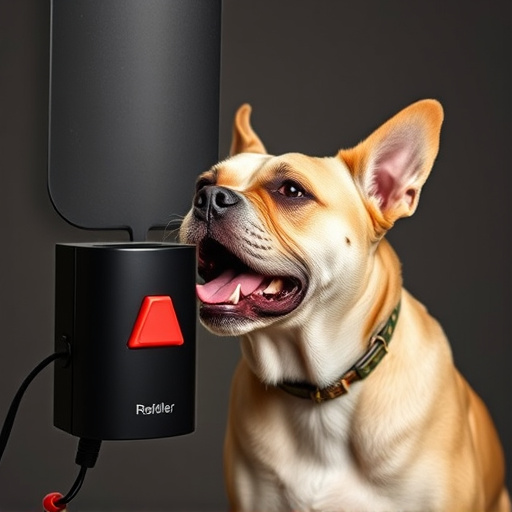Aggressive dog behavior can be deterred using Sonic Dog Repellers, which emit ultrasonic sound waves. Key installation areas include entry points and problem zones along fences. Proper placement, regular maintenance, and strategic mounting ensure their effectiveness. Additionally, positive pet training and personal safety tools like pepper spray enhance protection against aggressive canines.
Personal protection from aggressive dogs is a vital concern for many, especially given the potential risks of encounters. This comprehensive guide delves into effective strategies to safeguard yourself in such situations. We explore the underlying behavior of aggressive dogs, shedding light on recognizing warning signs through their body language and vocalizations. Additionally, we demystify sonic dog repellers—how they utilize sound waves to deter attacks and where best to install them for optimal protection.
- Understanding Aggressive Dog Behavior: Recognizing the Signs
- The Science Behind Sonic Dog Repellers: How They Work
- Installing a Sonic Dog Repeller: A Step-by-Step Guide
- Additional Tips for Personal Protection Against Aggressive Dogs
Understanding Aggressive Dog Behavior: Recognizing the Signs
Aggressive dog behavior can often be a result of fear, territoriality, or past traumatic experiences. Recognizing the signs early on is crucial for both your safety and that of the dog. Be vigilant for sudden snarling, stiffened postures, raised hackles along the back, and dilated pupils—these are common indicators of impending aggression. Such behaviors often precede a growl or an attack. If you notice these signs while approaching or interacting with a canine, it’s essential to understand that the dog is communicating its discomfort or danger threshold.
When dealing with potentially aggressive dogs, considering where to install a Sonic Dog Repeller can be beneficial. These devices emit high-frequency sound waves that are generally unpleasant for dogs, encouraging them to stay away from certain areas. Strategically placing one near entry points or in problem zones can help deter aggressive behavior and provide an additional layer of personal protection. Always remember that prevention and understanding canine communication are key when interacting with unfamiliar dogs.
The Science Behind Sonic Dog Repellers: How They Work
Sonic dog repellers have gained popularity as an effective, non-lethal method to protect individuals and pets from aggressive canine encounters. The technology behind these devices is based on sound waves, specifically ultrasonic frequencies that are inaudible to humans but irritating to dogs. These repellers emit a high-pitched tone when triggered by the presence of a dog, which then causes the animal to be disoriented and deterred.
Installation is a key factor in the success of sonic dog repellers. They should be strategically placed in areas where dog interactions are frequent or problematic, such as along fences bordering residential properties or public spaces. For best results, ensure the device’s sensor is unobstructed and pointed towards the expected path of potential dog intruders. Regular testing and battery maintenance are also crucial to keep the repeller functioning optimally.
Installing a Sonic Dog Repeller: A Step-by-Step Guide
Installing a Sonic Dog Repeller is an effective and non-lethal way to protect yourself and your loved ones from aggressive dogs. The device should be strategically placed in areas where dog encounters are most likely to occur, such as around your property’s perimeter or in specific rooms within your home. Start by identifying the ideal location; it should be a place visible to the dog, allowing the ultrasonic sound to reach them effectively. Typically, this could be near fences, gates, or entry points. Ensure the area is well-ventilated to maximize the device’s range and effectiveness.
Follow these simple steps:
1. Mounting: Securely attach the repeller to a sturdy surface using the included hardware. Follow the manufacturer’s instructions for the best placement, usually on walls or fences.
2. Power Source: Plug in the device and ensure it’s powered on. Most models operate on batteries, so test the battery life and replace as needed.
3. Testing: Activate the repeller and verify that the ultrasonic frequency is emitting clearly. Test its range by moving around to different spots where a dog might approach.
4. Adjustments: If necessary, adjust the device’s settings for optimal performance, ensuring it covers the desired area without causing distress to nearby humans or pets.
Additional Tips for Personal Protection Against Aggressive Dogs
When it comes to personal protection from aggressive dogs, there are several additional tips that can significantly enhance your safety. One innovative solution is the installation of a Sonic Dog Repeller. This device emits high-frequency sound waves that are unpleasant for dogs, effectively deterring them from approaching. Choose strategic locations like entry points, patios, or gardens where dogs might try to enter, ensuring maximum coverage and minimal disturbance to humans and other pets.
Regularly training and socializing your own pet is another crucial step. Positive reinforcement techniques can help calm anxious behavior and reduce the likelihood of aggression. Additionally, keeping a close eye on your surroundings when outdoors, especially in areas known for dog activity, can serve as an early warning system. Always carry essential items like pepper spray or a personal alarm designed to startle and disrupt potential attackers, giving you precious time to escape.
When it comes to personal protection from aggressive dogs, a sonic dog repeller can be an effective and humane deterrent. By understanding aggressive behavior and the science behind these devices, you can create a safer environment for yourself and others. Following our step-by-step guide on where to install a sonic dog repeller, along with additional tips, will help ensure your peace of mind. Remember, while these repellers offer protection, recognizing signs of aggression and taking preventive measures are key to staying safe around dogs.
